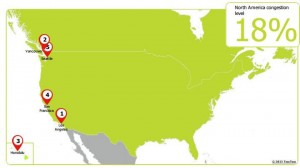
Contrary to what Virginians have been telling themselves, we really don’t have the worst traffic congestion in the country. You have to go to the west coast to experience world-class gridlock. (Click for more legible image.)
by James A. Bacon
One of the arguments driving the transportation-funding debate this spring was the factoid that Northern Virginia is one of the most congested regions of the country, if not the most congested region. The genesis of this claim came from the 2012 Urban Mobility Report published by the Texas Transportation Institute (TTI), which declared that the Washington region experienced more hours of delay per automobile commuter, at a higher cost in time wasted and gasoline burned, than anywhere else in the country.
If the Washington region ranked No. 1 in congestion, then surely Northern Virginia, which, anecdotally speaking, has the worst congestion in the Washington region, must be the worst in the country!
But TTI is not the only organization that measures traffic congestion. So does Tom Tom, a company that makes GPS-guided route-finding system, whose millions of customers feed data into what may be the largest database of travel times on the globe. And it turns out that Tom Tom’s measures of congestion don’t match up especially well with TTI’s, which is based upon data provided by INRIX using an arguably less robust methodology.
According to Tom Tom’s data, the Washington region ranked 6th in delay per peak auto commuter in the United States, behind Los Angeles, Honolulu, San Francisco, Seattle and San Jose, just to name the American cities. (Tom Tom also tracks travel times in Canadian cities, but I have deducted them from the rankings in order to create an apples-to-apples comparison with the TTI report.)
Hampton Roads ranked 24th for congestion among U.S. regions in Tom Tom’s congestion index compared to 20th in TTI’s ranking.
Conversely, Richmond ranked 51st among U.S. regions, according to Tom Tom, higher than TTI’s 60 ranking. In other words, Richmond is more congested than the conventional wisdom would suggest… though still relatively congestion-free by the standards of Washington and Hampton Roads.
Why does this matter? It matters because business, civic and political leaders had worked themselves into a lather this past year over Virginia’s supposedly crippling levels of traffic congestion. Heart-rending travel-time delays were driving away corporate investment and devastating our economic competitiveness. Virginia’s atrocious transportation tax restructuring/increase plan is the result. But if you believe Tom Tom’s data — which is based upon real-time traffic flows unlike TTI’s sampling-based methodology — the problem is significantly less acute in Northern Virginia and Hampton Roads compared to other major metropolitan regions than we have been told.
(While congestion may be worse than commonly thought in Richmond, that’s a non-factor politically because traffic delays there still don’t rise to the level of being a serious problem.)
As an aside, U.S. traffic congestion is milder overall than it is in European cities. Among capital cities, Moscow, Paris, Rome, Stockholm, Berlin and London all have higher levels of travel-time delay than Washington. (I am pleased to report, however, that the bicycle-friendly cities of Amsterdam and Copenhagen have among the lowest congestion rates, with my new favorite city in the world, Barcelona, not far behind.) And, for what it’s worth, Australian and New Zealand cities would rank among the worst in the U.S.
Dawn of the digital city. Which brings us to a totally unrelated but very interesting point… Tom Tom is yet another example of the potentially disruptive influence of information technology on transportation. As the company states:
By helping drivers to find a faster route we can also demonstrate that the total available capacity on the road network increases. If a small percentage of drivers uses different (and faster) routes, congestion can be alleviated across the entire road network, thereby benefiting all drivers.
By offering a more accurate analysis of traffic flows, we help identify and pinpoint congestion trouble spots more effectively. And by routing traffic away from congested areas we can play a key role in easing congestion in cities and urban areas.
We are witnessing the dawn of the digital city. Tom Tom, Google and others can provide us data that can help us better manage traffic and better target our infrastructure improvements. The information is there. We simply need to develop the analytics — and the will — to use it effectively.


